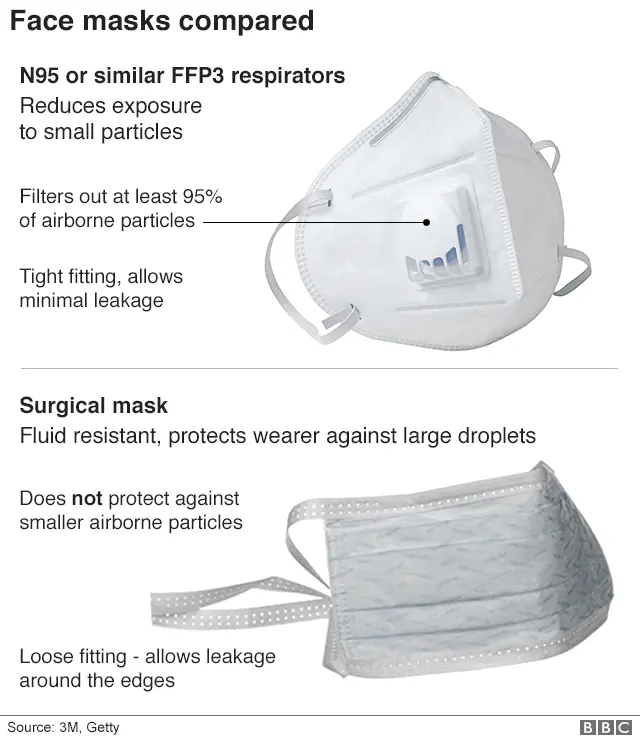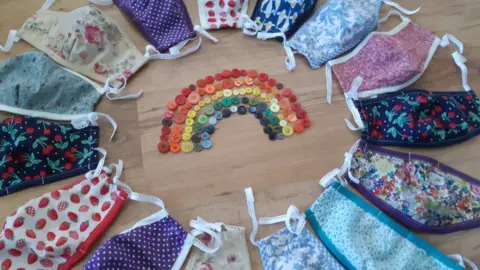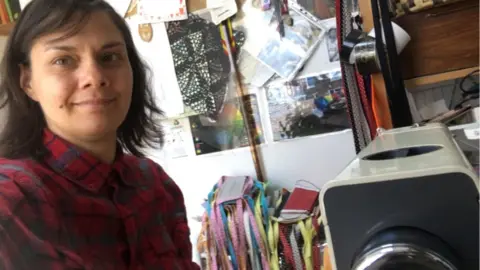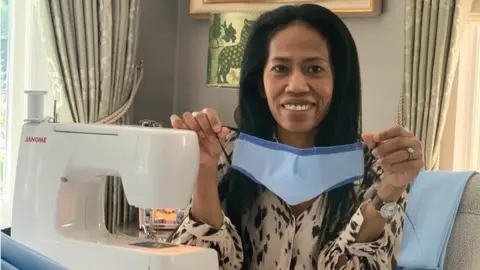Coronavirus: Making face masks feels 'like the war effort'
 Paola Despretz / Sophie Passmore
Paola Despretz / Sophie PassmoreLast summer, Sophie Passmore sat with a pot of glue and sequins, applying the finishing touches to costumes for ITV's reality show The Masked Singer. She didn't expect that, less than 10 months later, she would be replying to Facebook comments with advice for making a very different kind of mask.
She is one of thousands who have taken it upon themselves to produce cloth masks since the start of the coronavirus outbreak, despite official advice in the UK not to wear them. Requests for masks on social media have been met with offers from keen volunteers. Their destinations range from High Street shops to care homes and even - in one example given to the BBC - a hospital.
A debate around the use of face masks in the UK has been gaining momentum in recent weeks, with supporters of the idea - including London Mayor Sadiq Khan - arguing they can help reduce the risk of people with the virus passing it on to others. But the World Health Organization (WHO) has said there is no evidence to support the use of masks by the general population, and that people who are not in health and care facilities should only wear them if they are sick or caring for those who are.
Dr Jake Dunning of Public Health England said there is "little evidence of widespread benefit" of masks and that people should "prioritise good personal, respiratory and hand hygiene". However, on Tuesday, the government's scientific advisers met to discuss whether the public should be urged to wear them.
 PA Media
PA MediaSophie, who has made about 100 masks since she set up a Facebook support group with a friend last month, says she had to ask people not to post requests because members were "sewing through the night" to keep up with demand.
"Originally the majority of our requests were coming from care homes... but within the last three or four days it has been individuals," she says over the phone from her home in Brighton. "It was quickly running away from us."
Hospital bosses in the UK have warned that NHS supplies of face masks could be put at risk if the government starts advising the public to wear them. But Sophie stresses that the cloth masks she makes are very different from the surgical masks and N-95 respirators used in medical settings. She uses a pattern from the Centers for Disease Control in the US, which - unlike authorities in the UK - says homemade masks "can be used as an additional, voluntary public health measure".
They are made, essentially, from two pieces of breathable fabric and aim to reduce the amount of potentially harmful droplets the wearer breathes out, rather than preventing them from being breathed in.


About 80 miles away from Sophie in Poole, seamstress and tutor Amanda Brown is preparing to live-stream a tutorial for a more complicated pattern. She says that although she was sceptical about the effectiveness of homemade masks at first, she would, ultimately, want anybody who visited her elderly parents to wear one - even if there was only a small chance of reduced transmission.
"I like my masks to be colourful. I'm thinking: if I had an elderly parent or grandparent, and I've got somebody coming in with a mask on, I kind of want it to look colourful and pretty so it's not scary for them," she says.
 Amanda Brown
Amanda BrownIt can be an expensive hobby, according to Paola Despretz, who lives in London. She had been making masks for friends, family and local shop assistants using bed sheets and elastic from the supermarket, but had to bulk-buy elastic online after being asked to make 80 masks for a local hospital.
Paola reasons that a cotton mask is "better than nothing". But some mask-makers have inserted interfacing - blue paper towels or even vacuum cleaner filters - in the hope they will be able to protect themselves from breathing in the virus.
Dr Finola O'Neill, a GP from Devon and co-founder of the Masks4All campaign in the UK, which has attracted the support of more than 100 medics, stresses that homemade masks are not medical masks and urges people against including homemade filters.
"These are not supposed to be technical, we don't want any complications or risks," she says.

What are the rules around face masks?
- Official World Health Organization (WHO) guidance is that only people who have the virus or its symptoms and their carers need to wear face masks
- Medical masks should be kept for medical workers only, the WHO adds
- WHO special envoy David Nabarro believes that in society "some form of facial protection is going to become the norm"
- The UK government is currently following the advice saying masks are not necessary, although this is under review
- European advisers do not recommend reusable cloth masks, as they say they may even increase the chance of infection

WHO guidance issued this month warned that masks can create a "false sense of security" and lead to people ignoring other protective measures - and said they can even be a source of infection when not used correctly. But Dr O'Neill says these are "assumptions" and that people should be trusted when it comes to standards of hygiene.
"The public have been really, really co-operative with everything they've been asked to do. They've been amazing. So I see no reason why they wouldn't do the same here," she says. She points out that people in other countries have been told to wear masks.
 Sophie Passmore
Sophie Passmore Sophie believes a real sense of community has been born out of the crisis. "It feels like the war effort," she says, referring to the production of clothing for soldiers on the home front during World War One and World War Two. "People who are sewing really have a purpose right now, we feel that we're doing something to help."
While her Facebook group acts as a support network, Amanda's local group is more like a production line. The founders rely on donations to gather the materials. Designated local coordinators deliver them to individual members who produce the masks. They are then collected, washed, and distributed.
"Everybody's kind of working in a chain, it's quite sweet really," Amanda says, adding that she hopes it will prompt an interest in sewing.
 Pratthana Sherring
Pratthana SherringOne of the local seamstresses is Pratthana Sherring, who took out her sewing machine from the attic for the first time in a decade.
"The woman who dropped off the fabric, I don't even know her. It's a big community and people want to put their hands up and help," she says.

- A SIMPLE GUIDE: How do I protect myself?
- AVOIDING CONTACT: The rules on self-isolation and exercise
- HOPE AND LOSS: Your coronavirus stories
- LOOK-UP TOOL: Check cases in your area

